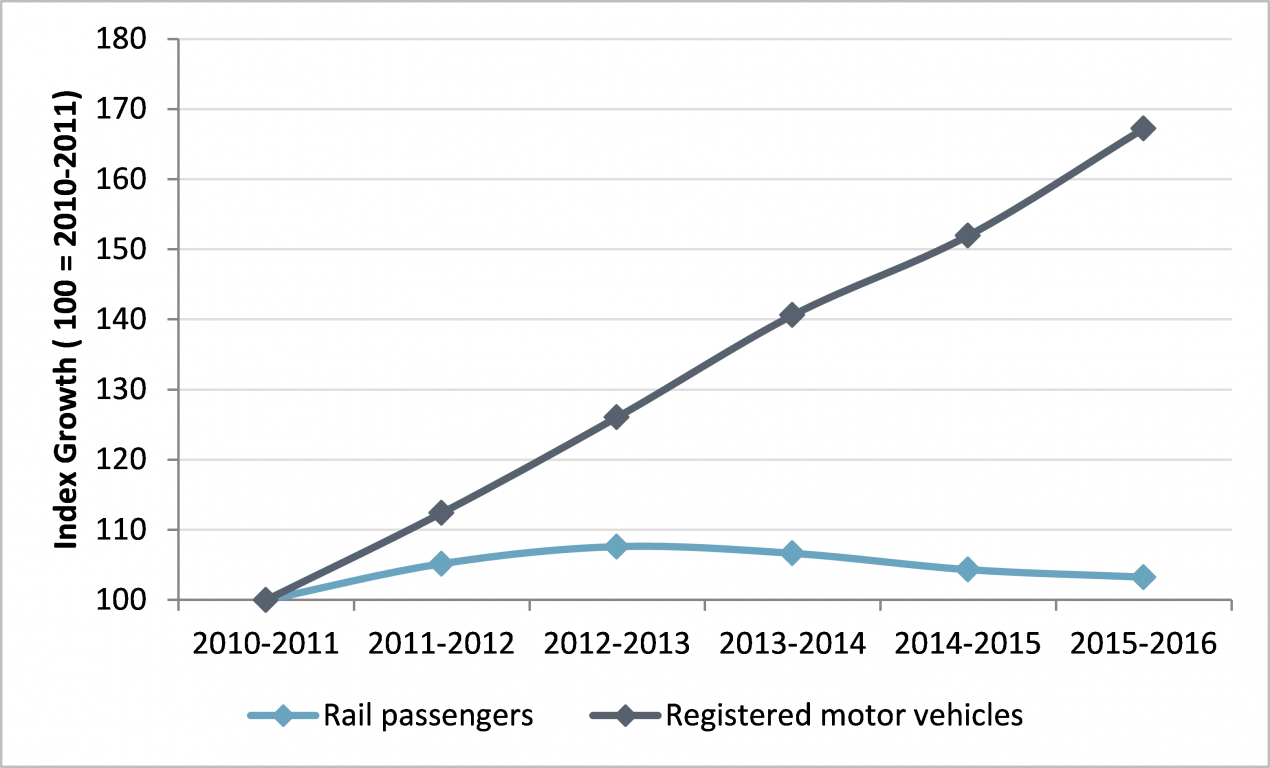India’s railway network is one of the largest in the world comprising 92,081 km of track and 7,216 stations, carrying 22 million passengers a day and 1.1 billion tons of freight annually¹. Due to its prominent role in the infrastructure landscape of the country there have been many Government-led initiatives to invest in the network and station infrastructure. This investment program comes in the context of increased competition from road transport, which has recorded a much faster growth than rail passenger numbers in recent years with no indication that this trend is going to reverse anytime soon.
Source: Steer Davies Gleave Analysis of Indian Railways passenger data (2016) and MORTH, Road Transport Year Book (2016)
The main reason is, of course, the lack of investment and capacity on the railways, which makes travel across long distances very time consuming and unreliable, and travel on the suburban network often substandard in terms of safety and comfort.
One important part of the investment is focused on capital projects to ease traffic and increase capacity such as the allocation of Rs 24,374.86 crore (US$ 3.63 billion) by the Cabinet Committee on Economic Affairs (CCEA) for nine projects to expand the network and increase connectivity, and Rs 121,000 crore (US$ 18.04 billion) allocated on the 2016-17 Railway Budget for joint ventures with states and developing new frameworks for public-private partnership (PPP)².
Investment is not only directed to increasing capacity but also increasing environmental credentials and reducing dependence on fossil fuels by installing roof solar panels at stations as part of the Solar Mission of Indian Railways. Other important investments are directed toward digitization of the network by introducing bar-coded tickets; GPS based information systems inside coaches, Information Technology (IT) integration of all facilities dealing with ticketing issues, Wi-Fi facilities at the stations or super-fast long-route train service for unreserved passengers.
A notable initiative is also the partnership of Indian Railway with Google and Railtel to launch RailWire Wifi, which involves providing infrastructure for high-speed Wi-Fi across 400 stations in India. Mumbai Central was the first rail station to get Wi-Fi in January 2016 as part of this initiative³.
The allocation in investment is accompanied by reforms such as abolishing the separate rail budget, decentralizing decision-making, introducing greater transparency through e-tendering and allowing more private investment on the network to help it expand, modernise, improve efficiency and meet customer expectations.
Recognising and addressing the last mile challenge
Whilst the investment plans are truly ambitious they fail to explicitly recognise a long term challenge that will increasingly affect not only travel on the railways but all public transport options both in India and in other parts of the world. This long term challenge is the increasing need and preference for more flexible, point to point journeys.
In order to overcome this challenge rail stations need to be increasingly well integrated with first and last mile travel options.
One of the main challenges for Indian rail stations is recognising and investing in facilities to enhance first/last mile connectivity. Poorly designed drop-off areas, guard railing, fencing or grade separation, lack of legible signage, encroachments of walking spaces are common features of areas around Indian stations causing severance for passengers being dropped off or approaching the station from nearby areas. There is limited and inconsistent provision for safe crossings, making it difficult and often time consuming for passengers to cross the street. As a consequence unsafe behaviours such as pedestrians walking through or along moving traffic to cross the street are very common. This lack of provision for safe walking also leads to passengers favouring other first/last mile options such as private cars, two and three wheelers and, increasingly, taxis, which further constrains the limited space available around rail stations.
On-demand taxi services, such as Uber and Ola, are very popular with both companies reporting a total of 900,000 registered drivers and the third biggest market after China and North America for cab aggregators in terms of rides. Bike rentals are also catching up with relatively new enterprises such as Volta Motors based in Chennai and services such as UberMOTO launched at the end of last year in Hyderabad. Whilst technology companies are wisely taking advantage of a very fast growing market the physical planning and integration of these solutions at railway stations and public transport terminals is very limited.
A change from trusted traditional approaches will always be a challenge to the received wisdom. It will call for objective and insightful analysis, creativity to develop the new approaches, determination to successfully implement them and a shared willingness to critically appraise what has worked and what has not. This requires a holistic understanding of stations from multiple perspectives and an appreciation of the different needs, expectations and issues for different station users. Perpetuating traditional approaches to design and management will not work to meet the aspirational, consumer and legacy challenges. As a consequence first/last mile provision at rail stations should be recognised and prioritised in investment decisions.
___________
¹ http://www.indianrailways.gov.in/railwayboard/uploads/directorate/stat_econ/IRSP_2015-16/Summary%20Sheet_Eng_pdf_pdf.pdf
² http://www.ibef.org/industry/indian-railways.aspx
³ http://www.gizbot.com/internet/features/8-exciting-initiatives-that-google-has-taken-india-under-sundar-pichais-leadership/slider-pf69883-037319.html
